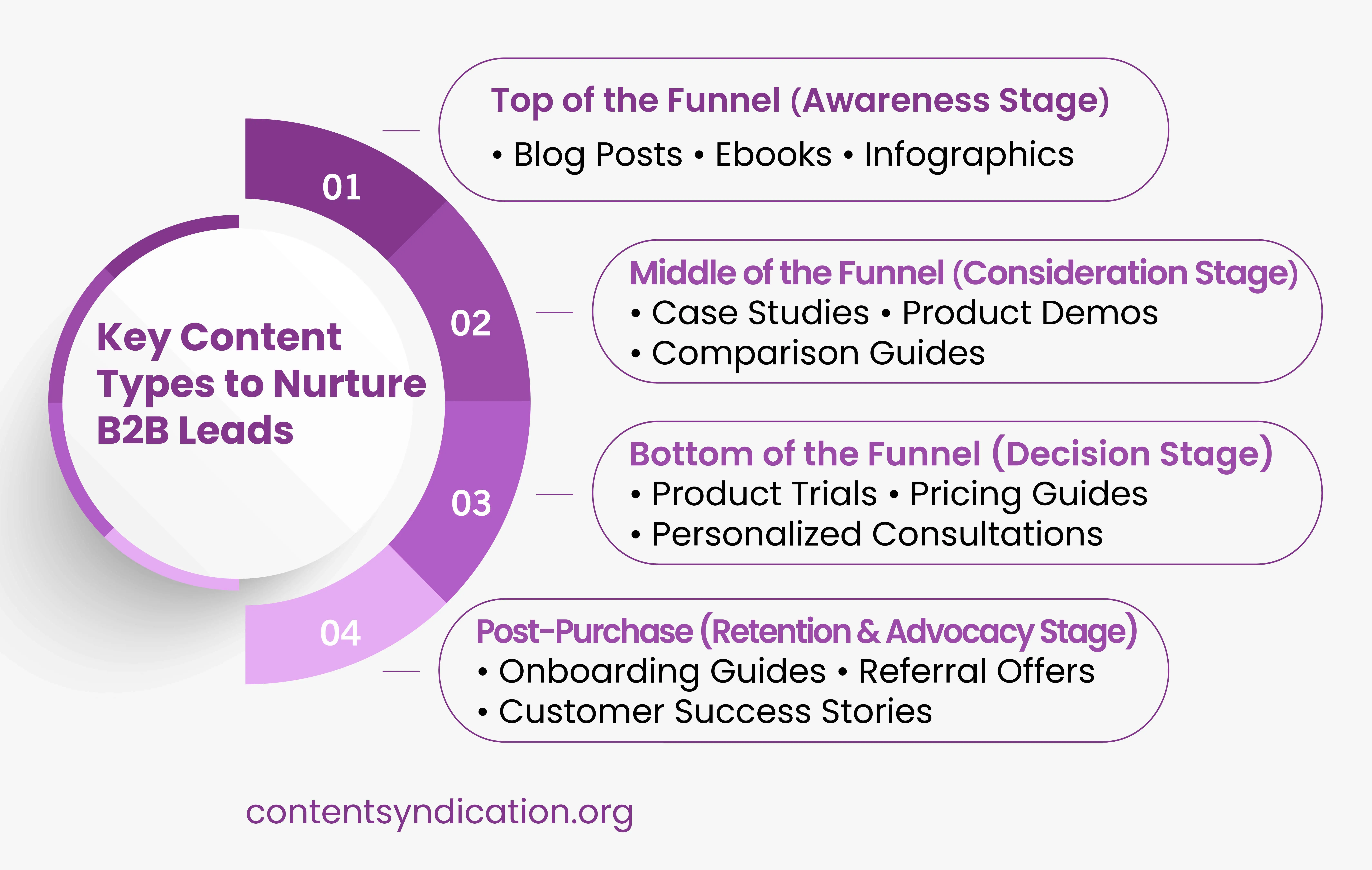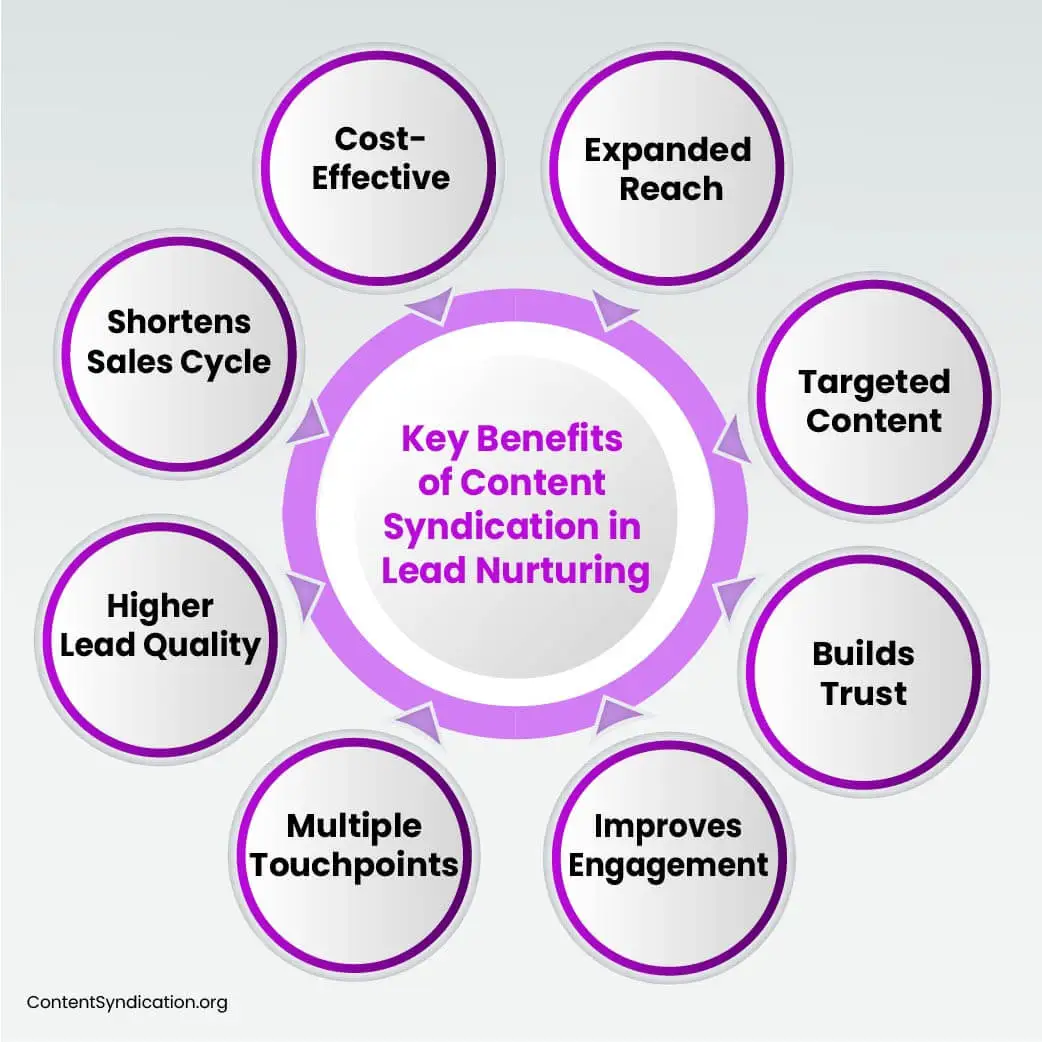Content syndication generates high-quality B2B leads. Really?
Think.
In the B2B world, where sales cycles are long, budgets are significant, competition is fierce, high-quality leads from content syndication? Rare.
However, it helps by expanding your reach and attracting early-stage prospects. But these leads need nurturing.
Once shiny leads enter your lead nurturing funnel, you must guide them through the buyer’s journey. Gently coaxing them toward conversion.
All in all, these are early-stage prospects, where you need a solid lead nurturing strategy- to move them along their buying journey.
Keep reading to discover how.
What is Content Syndication in Lead Nurturing?
Content syndication is the process of distributing content—such as blog posts, whitepapers, eBooks, and case studies—across third-party platforms to expand reach and attract new leads.
The leads generated through this method typically sit at the top of the funnel. Most of the time. Probably they might not have heard of your company.
These are in the early buying stage. They need nurturing.
Deliver the content that aligns different stages of the buyer’s journey. This ensures that leads are continuously engaged and educated until they are ready to make a purchase.
How is it different from traditional content marketing?
Traditionally, content syndication was about lead generation. But today it has evolved. And now plays a crucial role in nurturing leads.
Once leads engage with syndicated content, you can track their interactions and customize future communications. And by guiding them through the buyer’s journey, you keep them actively moving through the funnel.
The Role of Content Syndication in Lead Nurturing
AI has made content syndication more efficient, precise, and scalable. AI for content syndication, marketers can now leverage advanced algorithms to reach the right audiences with minimal manual effort. Traditionally, marketers had to manually distribute content and track performance, but AI now automates and optimizes these tasks.
Here are the key stages where content syndication plays a role:
1. Awareness Stage: Attracting New Leads
At the top of the funnel, leads are in the research phase. Looking for potential solutions to their challenges.
Through content syndication, you can introduce your brand by sharing educational and informative content on third-party platforms.
However, with a large volume of content being syndicated across the web, it’s easy for you to get lost in a sea of similar educational pieces, reducing its effectiveness.
High-quality content wins. Prioritize it. Deliver content that is well-researched. That speaks directly to your audience’s needs, pain points, and industry trends.
Remember at this point, you don’t need to be pushy. Focus on providing valuable content that addresses key trends and common challenges. This helps build credibility and opens the door for deeper engagement.
For instance, syndicated blog posts, industry reports, or infographics shared on platforms like Outbrain or LinkedIn can help broaden your brand’s reach.
2. Consideration Stage: Engaging Interested Prospects
Your leads are in the middle of the funnel. Evaluating potential solutions. Your content needs to be specific, insightful, and problem-solving. And if the syndicated content is too broad or generic, it can fail to meet their needs, causing disengagement.
To keep them engaged, syndicate content like case studies, product comparisons, and webinars that showcase how your solution addresses their specific pain points.
This type of targeted content nurtures leads, helping them make informed decisions while subtly guiding them to see your product as the best solution.
3. Decision Stage: Supporting the Purchase Decision
The prospect is nearly convinced but may still have lingering concerns or objections. Concerns, such as budget constraints, implementation timelines, or uncertainty about ROI, may prevent them from making a final decision.
It’s tempting to switch to a more aggressive, sales-heavy approach, isn’t it?
Yes, but what you really need is detailed, solution-based content to reaffirm their decision.
The assumption that removing educational content and pushing harder will close the deal can be misleading
Instead, use content syndication to address any remaining objections. Syndicated content, such as product demos, free trials, or in-depth ROI analyses, can showcase your brand’s value and encourage leads to take the final step.

Best Practices for Using Content Syndication in Lead Nurturing
To maximize the effectiveness of content syndication in lead nurturing, it’s essential to follow best practices so that your content reaches the right audience at the right time.
1. Segment Your Audience for Personalization
Segmenting your audience for personalization. Sounds simple. But in reality, it can be more complex than it seems.
Segment your leads based on factors like industry, job role, company size, and buyer journey stage.
Thanks to AI and machine learning tools, leads can be automatically segmented based on behavior and demographic data.
These technologies help identify patterns in lead behavior and create segments that are more likely to engage with personalized content.
Platforms like Outbrain and Taboola can syndicate content based on specific audience preferences.
2. Use Data-Driven Insights to Refine Content
To understand which topics and formats resonate with your audience, track engagement metrics such as clicks, downloads, shares, and other relevant data points. This helps you make informed decisions about your content strategy.
Remember, not all metrics are equal. Focusing too heavily on vanity metrics like clicks or views may not give a complete picture.
Instead track engagement metrics like clicks, downloads, and shares which provide better insights into what content is resonating with your audience.
This data can guide you for future content syndication efforts and improve the relevance of your content.
By analyzing this information, you can better nurture leads by delivering the content they are most interested in.
3. Leverage AI and Automation for Predictive Distribution
AI and machine learning optimize content syndication—but how?
They predict which content will engage specific audience segments and distribute it based on lead preferences.
However, these models depend on accurate data. If the data is biased or incomplete, predictions can fall short.
So, how do you improve accuracy?
Regularly clean and update your data, ensuring diverse inputs. This enhances AI precision, leading to more personalized and effective content distribution.
4. Build a Consistent Syndication Calendar
Consistency is key in lead nurturing. And a syndication calendar makes sure your content is regularly distributed across multiple platforms. Keeping your brand visible and relevant.
Calendars can be set and forgotten? In reality, a syndication calendar requires regular updates to adapt to changing market trends and audience preferences.
The solution? Continuously review and adjust your calendar based on analytics and feedback. Keep your content timely and aligned with evolving audience needs, so that you ensure sustained engagement and lead conversion.
This kind of content nurtures leads, helping them make informed decisions while subtly guiding them toward viewing your product as the best solution.

Benefits of Content Syndication for Lead Nurturing
Content syndication offers several benefits that enhance the lead nurturing process and drive higher conversions:
1. Multi-Touch Engagement Across Channels
Lead nurturing requires ongoing interaction- across various channels. Content syndication allows you to maintain engagement by distributing content on third-party platforms that your prospects already use.
This multi-touch approach keeps your brand top of mind, ensuring leads stay engaged throughout the buyer’s journey.
2. Extended Reach Beyond Owned Channels
Sure, email and website engagement are effective lead-nurturing channels. But they are limited to leads already familiar with your brand.
Content syndication, on the other hand, extends your reach to new prospects who haven’t yet visited your site, allowing you to nurture them with valuable content across external platforms.
3. Better Lead Qualification Through Data
Syndicated content offers valuable insights into lead behavior by tracking which content they engage with and how they interact with it.
This helps improve your lead scoring and qualification processes.
The result? Your sales team can focus on the most promising leads, making sure you’re nurturing the right prospects.
Conclusion: The Future of Content Syndication in Lead Nurturing
In conclusion, even the most well-executed content syndication campaigns won’t yield successful results. That’s because leads you’re working with aren’t of high quality from the start.
So, it’s crucial not to invest time nurturing leads that are unlikely to align with your product offering, or worse, passing them on to your sales team.
Partnering with a trusted vendor ensures your syndication efforts generate high-quality leads that match your Ideal Customer Profile (ICP), while keeping cost-per-lead predictable and manageable.
Frequently Asked Questions (FAQs)
What is the difference between lead generation and lead nurturing in content syndication?
Lead generation through content syndication focuses on attracting top-of-funnel leads by publishing content on third-party platforms.
Lead nurturing comes afterward—guiding those early-stage leads through the buyer journey using personalized, stage-specific content to build trust, increase engagement, and prepare them for conversion.
Are syndicated leads high quality for lead nurturing?
Not always. Syndicated leads are typically early-stage and unaware of your brand, so they require careful nurturing. However, when partnered with reputable vendors and paired with targeted, well-crafted content, they can convert into high-quality, sales-ready leads over time.
How do I nurture syndicated leads effectively?
To nurture syndicated leads:
- Segment them based on intent, industry, or buyer journey stage
- Deliver personalized content at each stage (e.g., blogs in awareness, case studies in consideration, ROI tools in decision)
- Track behavior and engagement to trigger timely follow-ups or automation sequences
What types of content work best for each stage of nurturing?
- Awareness: Blog posts, trend reports, infographics, checklists
- Consideration: Webinars, whitepapers, comparison guides, case studies
- Decision: Product demos, ROI calculators, customer testimonials, pricing FAQs
Each content type should align with the lead’s intent and position in the funnel.
How does AI improve content syndication in lead nurturing?
AI helps by:
- Segmenting leads based on behavior and intent
- Predicting the right content to serve at the right time
- Automating syndication and retargeting across channels
- Tracking performance in real-time to improve personalization and outcomes
This makes nurturing more scalable and efficient.
How can I avoid content fatigue during syndication?
- Use a syndication calendar to maintain consistency without repetition
- Repurpose content into different formats (e.g., blog → infographic → video snippet)
- Personalize content per platform and audience segment
- Monitor engagement to avoid overexposing the same piece of content
What tools can help automate and track syndicated lead nurturing?
- HubSpot and Marketo: Lead segmentation and nurturing workflows
- Outbrain / Taboola: AI-driven content syndication to targeted audiences
- Google Analytics / UTMs: Performance tracking
- Salesforce / CRM: Monitor lead stages and engagement levels
Can content syndication help with lead scoring?
Yes. By tracking engagement metrics (e.g., content downloaded, time spent, click-through rates), you can assign scores to leads. This helps your marketing and sales teams prioritize high-intent leads who are more likely to convert.
How often should I syndicate content to nurture leads?
Consistency is key. A monthly or bi-weekly cadence is a good starting point. But frequency should depend on:
- Your audience’s content consumption habits
- Performance data
- Resource capacity to produce or repurpose quality content
What’s the biggest mistake marketers make when using content syndication for nurturing?
Assuming that content syndication is a one-time effort or only for lead gen. The real value lies in:
- Aligning content with buyer stages
- Monitoring and optimizing based on engagement
- Choosing the right vendors to ensure ICP-fit leads
Failing to do this results in wasted time nurturing the wrong leads—or passing them to sales prematurely.




